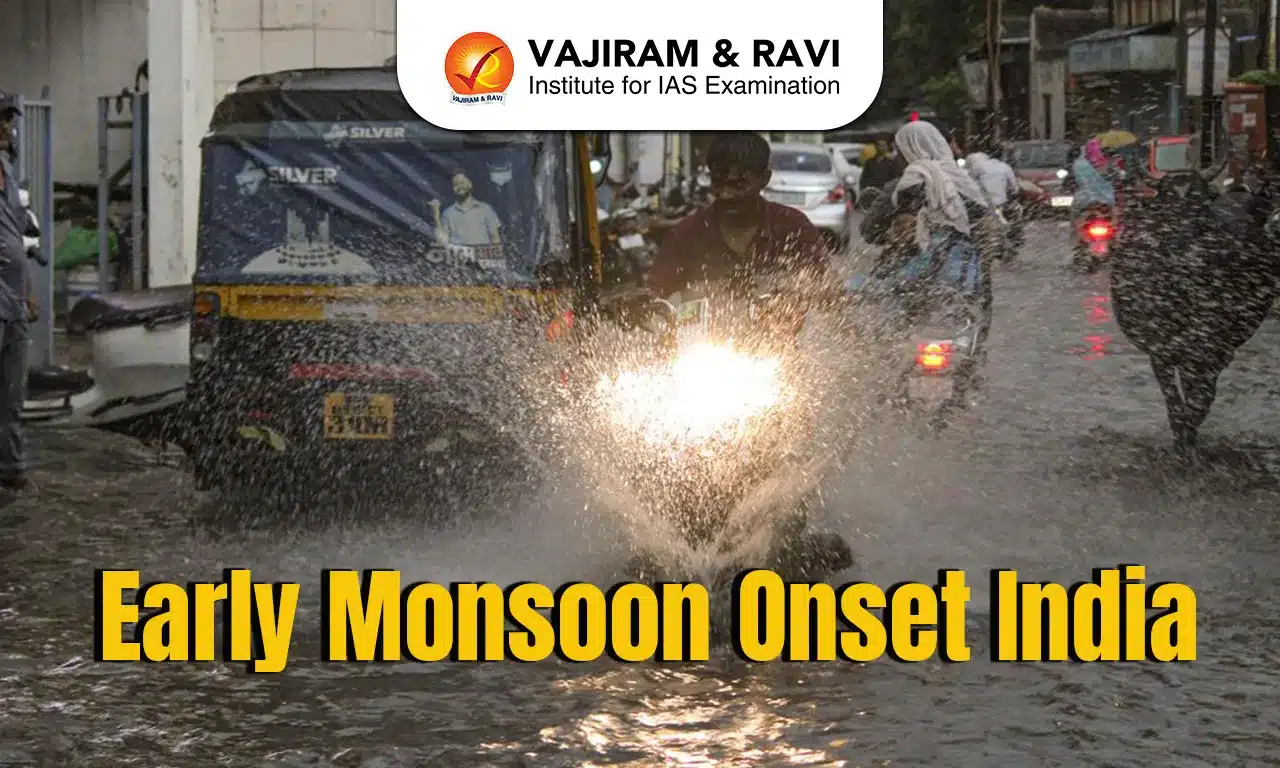Early Monsoon Onset India Latest News
- The IMD declared monsoon onset over Kerala on May 24, eight days earlier than the normal June 1 schedule. This onset signals the start of the June–September southwest monsoon, which delivers over 70% of India’s annual rainfall, making it vital for agriculture and the economy.
- The last time the monsoon arrived this early was in 2009, on May 23.
Monsoon Onset Declaration: Criteria and Process
- The IMD attempts to declare the schedule for southwest monsoon onset any time after May 10. To do so, certain essential criteria are considered.
Key Criteria for Onset
- Rainfall
- At least 60% of 14 designated southern meteorological stations (including Thiruvananthapuram, Kochi, Mangalore, etc.) must report ≥2.5 mm rainfall for two consecutive days.
- Wind Field
- Westerly winds must dominate up to 600 hPa pressure level.
- Wind speed at 925 hPa must range between 15–20 knots (27–37 km/h).
- Outgoing Longwave Radiation (OLR)
- The Earth absorbs and reflects solar energy, affecting global temperature and climate.
- Aerosol particles in the atmosphere can absorb sunlight, contributing to atmospheric warming.
- The absorbed energy is re-emitted as longwave infrared radiation (OLR).
- OLR mainly originates from the warmed upper atmosphere, with some from the Earth’s surface.
- This radiation helps warm the lower atmosphere, which in turn warms the Earth’s surface.
- OLR values must be below 200 W/m², indicating favorable atmospheric conditions for monsoon onset.
IMD Declaration
- The monsoon onset is declared on the second day after all above conditions are met.
This Year’s Onset
- A simultaneous onset occurred over Kerala, Lakshadweep, Mahe (Puducherry), parts of the Arabian Sea, Bay of Bengal, and southern Karnataka and Mizoram.
Factors Behind Early Monsoon Onset in India
- The early onset of the southwest monsoon was driven by favourable atmospheric and oceanic conditions.
- A low-pressure area over the Arabian Sea and a trough over Vidarbha enhanced moisture inflow and atmospheric convection, accelerating the monsoon’s advance.
Madden-Julian Oscillation (MJO)
- MJO is a significant and complex ocean-atmosphere phenomenon that originates in the Indian Ocean and plays a crucial role in influencing the Indian monsoon.
- It involves disturbances in clouds, winds, and pressure that move eastward at a speed of 4–8 metres per second.
- These disturbances, known as MJO wind bands, can circle the globe within 30 to 60 days and lead to major weather changes along their path.
- When the MJO is in a favourable phase, it can enhance rainfall over India during the monsoon season.
Mascarene High
- The IMD describes the Mascarene High as a high-pressure area found around the Mascarene Islands (in the south Indian Ocean) during the monsoon period.
- The variation in the intensity of high pressure is responsible for heavy rains along India’s west coast.
Convection and Rainfall
- An increase in convective activity—vertical movement of heat and moisture in the atmosphere—can lead to rainfall.
- For example, a convective system over Haryana recently moved southeastward and caused rain in the Delhi region.
Somali Jet and Monsoon Strength
- The Somali jet is a low-level, cross-equatorial wind system originating near Mauritius and north Madagascar.
- By May, it crosses the east coast of Africa and reaches the Arabian Sea and the west coast of India.
- A strong Somali jet enhances the monsoon winds, contributing to a robust monsoon.
Heat-Low and Moisture Inflow
- With the Sun’s shift to the northern hemisphere during summer, a low-pressure zone forms over the Arabian Sea.
- A heat-low over Pakistan and nearby regions acts like a suction pump, drawing moist air into the monsoon trough and intensifying monsoon rainfall.
Monsoon Trough
- The monsoon trough is an elongated low-pressure area stretching from the heat low over northwest India to the north Bay of Bengal.
- Its north-south oscillation brings rainfall across the core monsoon zone during June to September.
- Additionally, the pressure gradient and the monsoon onset vortex—a cyclonic system in the Arabian Sea—contribute to the timely and strong onset of the monsoon.
Early Monsoon Onset India FAQs
Q1. When did the 2025 monsoon begin in India?
Ans. On May 24, eight days earlier than the normal onset date of June 1.
Q2. What is the Madden-Julian Oscillation (MJO)?
Ans. A global weather system that enhances rainfall when in a favourable phase over the Indian Ocean.
Q3. How does the Somali Jet affect monsoons?
Ans. A strong Somali Jet enhances monsoon winds, boosting rainfall along India’s west coast.
Q4. What is the role of the heat-low?
Ans. It draws moist air from the sea into the land, strengthening the monsoon trough.
Q5. Why is OLR important for monsoon onset?
Ans. Low OLR values (<200 W/m²) indicate atmospheric conditions favorable for monsoon development.
Last updated on December, 2025
→ Check out the latest UPSC Syllabus 2026 here.
→ Join Vajiram & Ravi’s Interview Guidance Programme for expert help to crack your final UPSC stage.
→ UPSC Mains Result 2025 is now out.
→ UPSC Notification 2026 is scheduled to be released on January 14, 2026.
→ UPSC Calendar 2026 is released on 15th May, 2025.
→ The UPSC Vacancy 2025 were released 1129, out of which 979 were for UPSC CSE and remaining 150 are for UPSC IFoS.
→ UPSC Prelims 2026 will be conducted on 24th May, 2026 & UPSC Mains 2026 will be conducted on 21st August 2026.
→ The UPSC Selection Process is of 3 stages-Prelims, Mains and Interview.
→ UPSC Result 2024 is released with latest UPSC Marksheet 2024. Check Now!
→ UPSC Prelims Result 2025 is out now for the CSE held on 25 May 2025.
→ UPSC Toppers List 2024 is released now. Shakti Dubey is UPSC AIR 1 2024 Topper.
→ UPSC Prelims Question Paper 2025 and Unofficial Prelims Answer Key 2025 are available now.
→ UPSC Mains Question Paper 2025 is out for Essay, GS 1, 2, 3 & GS 4.
→ UPSC Mains Indian Language Question Paper 2025 is now out.
→ UPSC Mains Optional Question Paper 2025 is now out.
→ Also check Best IAS Coaching in Delhi
Tags: early monsoon onset india mains articles upsc current affairs upsc mains current affairs

















